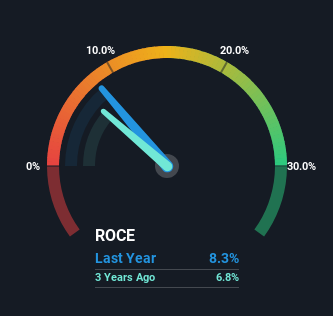- South Korea
- /
- Auto Components
- /
- KOSDAQ:A067570
NVH Korea (KOSDAQ:067570) Is Doing The Right Things To Multiply Its Share Price
What are the early trends we should look for to identify a stock that could multiply in value over the long term? Amongst other things, we'll want to see two things; firstly, a growing return on capital employed (ROCE) and secondly, an expansion in the company's amount of capital employed. Put simply, these types of businesses are compounding machines, meaning they are continually reinvesting their earnings at ever-higher rates of return. So on that note, NVH Korea (KOSDAQ:067570) looks quite promising in regards to its trends of return on capital.
What Is Return On Capital Employed (ROCE)?
Just to clarify if you're unsure, ROCE is a metric for evaluating how much pre-tax income (in percentage terms) a company earns on the capital invested in its business. Analysts use this formula to calculate it for NVH Korea:
Return on Capital Employed = Earnings Before Interest and Tax (EBIT) ÷ (Total Assets - Current Liabilities)
0.083 = ₩51b ÷ (₩1.3t - ₩721b) (Based on the trailing twelve months to March 2024).
Thus, NVH Korea has an ROCE of 8.3%. On its own, that's a low figure but it's around the 8.8% average generated by the Auto Components industry.
See our latest analysis for NVH Korea

Historical performance is a great place to start when researching a stock so above you can see the gauge for NVH Korea's ROCE against it's prior returns. If you'd like to look at how NVH Korea has performed in the past in other metrics, you can view this free graph of NVH Korea's past earnings, revenue and cash flow.
How Are Returns Trending?
Even though ROCE is still low in absolute terms, it's good to see it's heading in the right direction. Over the last five years, returns on capital employed have risen substantially to 8.3%. Basically the business is earning more per dollar of capital invested and in addition to that, 75% more capital is being employed now too. So we're very much inspired by what we're seeing at NVH Korea thanks to its ability to profitably reinvest capital.
Another thing to note, NVH Korea has a high ratio of current liabilities to total assets of 54%. This effectively means that suppliers (or short-term creditors) are funding a large portion of the business, so just be aware that this can introduce some elements of risk. While it's not necessarily a bad thing, it can be beneficial if this ratio is lower.
What We Can Learn From NVH Korea's ROCE
All in all, it's terrific to see that NVH Korea is reaping the rewards from prior investments and is growing its capital base. Considering the stock has delivered 14% to its stockholders over the last five years, it may be fair to think that investors aren't fully aware of the promising trends yet. So with that in mind, we think the stock deserves further research.
NVH Korea does have some risks, we noticed 5 warning signs (and 3 which are potentially serious) we think you should know about.
While NVH Korea may not currently earn the highest returns, we've compiled a list of companies that currently earn more than 25% return on equity. Check out this free list here.
Valuation is complex, but we're here to simplify it.
Discover if NVH Korea might be undervalued or overvalued with our detailed analysis, featuring fair value estimates, potential risks, dividends, insider trades, and its financial condition.
Access Free AnalysisHave feedback on this article? Concerned about the content? Get in touch with us directly. Alternatively, email editorial-team (at) simplywallst.com.
This article by Simply Wall St is general in nature. We provide commentary based on historical data and analyst forecasts only using an unbiased methodology and our articles are not intended to be financial advice. It does not constitute a recommendation to buy or sell any stock, and does not take account of your objectives, or your financial situation. We aim to bring you long-term focused analysis driven by fundamental data. Note that our analysis may not factor in the latest price-sensitive company announcements or qualitative material. Simply Wall St has no position in any stocks mentioned.
About KOSDAQ:A067570
NVH Korea
Engages in the manufacture and sale of automotive noise, vibration, and heat control parts in South Korea and internationally.
Slight risk second-rate dividend payer.
Market Insights
Community Narratives



